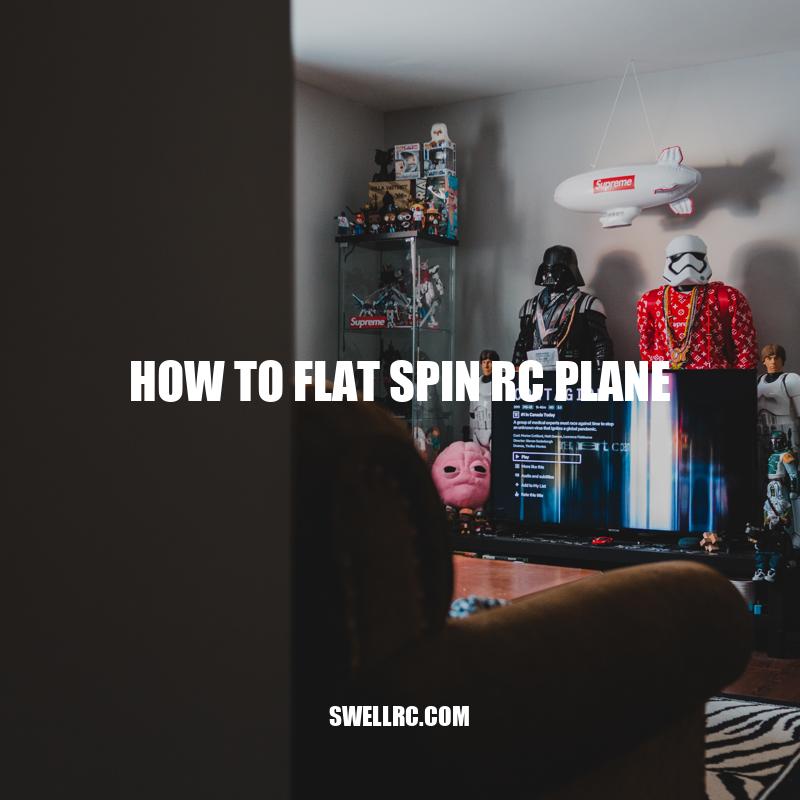How to Flat Spin a RC Plane: Step-by-Step Guide
Flat spinning is a spectacular maneuver that many RC pilots aspire to master. This maneuver involves inducing the plane to spin on its horizontal axis while simultaneously flying forward, creating a flat spin. It is a challenging but rewarding skill to acquire. Learning to perform the flat spin requires practice, patience, and a proper understanding of the technique involved. In this article, we will explore the step-by-step process to learn how to flat spin an RC plane. Before we delve into the procedure, it is worth noting that a flat spin should only be performed by experienced pilots who understand the risks and safety precautions involved. It is advisable to practice this maneuver in a simulator before attempting it in real life.
Preparation
Before attempting a flat spin, it’s vital to make the necessary preparations. Here are some steps to follow:
- Choose the right plane – A plane designed for aerobatic maneuvers would be best suited for this move. A stable and light plane recommended, such as a Balsa wood model.
- Choose the right location – A flat and open space with no objects obstructing the flight path is ideal.
- Gain enough experience first – You should have experience with other types of moves such as loops and rolls before attempting a flat spin.
It’s essential to understand that performing a flat spin is not easy, and it requires a great deal of practice and dedication. Invest time in selecting the right spot and, most importantly, be ready to fail repeatedly before succeeding. Also, consider purchasing a simulator such as the RealFlight 9.5 as an excellent option to achieve that steady and stable environment to practice.
How do you do a flat spin?
To execute a flat spin, you need to follow these steps:
- Enter a steep climb or perform an inside loop.
- When you reach the top, reduce the power and apply full rudder to one side.
- As the aircraft starts to yaw, apply full opposite aileron and hold this position.
- The aircraft will start to spin flat as it descends.
- As the aircraft approaches the ground, release the rudder and apply opposite aileron to level the wings.
It is important to note that flat spins can be dangerous and should only be done under the supervision of a qualified instructor. Never attempt it without proper training and experience.
If you want to learn more about aerobatics and flying techniques, there are several websites and products available online. One such website is the International Aerobatic Club (IAC), which offers resources and events for aerobatic enthusiasts. There are also instructional DVDs and books available from reputable aviation publishers that can help you enhance your flying skills.
Getting Started
Now that you’ve chosen the right plane, location, and have enough experience, it’s time to get started with the flat spin.
Follow these easy steps to get started:
| Step | Action |
|---|---|
| 1 | Build up some speed by flying straight and level. |
| 2 | Start with a normal spin before transitioning to a flat spin. |
| 3 | Begin to flatten out the spin using the elevator stick. |
It’s important to note that a flat spin is a dangerous maneuver if not executed correctly, and it requires a lot of time and patience to master. No worries, though; with lots of training and practice, you will eventually get the hang of it, and you will experience the rush of adrenaline at the moment of the move.
If you’re looking for the perfect plane for this maneuver, we recommend the American Champion Decathlon. It’s a reliable and sturdy aircraft that will help you execute the perfect flat spin.
How do you initiate a flat spin?
Initiating a flat spin involves a combination of rudder and elevator inputs, which causes the plane’s heading to spin around its vertical axis while simultaneously falling towards the ground. Here are the steps to initiate a flat spin:
- Enter a stall by pulling the plane’s nose up until it loses lift and begins to fall
- Use the rudder to yaw the plane in the desired direction of the spin
- Simultaneously use the elevator to pitch the plane down and keep it in the stalled condition
It is important to note that flat spins are hazardous and should only be attempted by experienced pilots with proper training and in a properly equipped aircraft.
If you are interested in learning more about aviation or becoming a pilot, check out websites such as AOPA (https://www.aopa.org/) or Pilot Institute (https://www.pilotinstitute.com/).
Executing the flat spin
Now that you’ve built up some speed and started to transition into the flat spin, it’s time to execute the maneuver.
Follow these easy steps to execute the flat spin:
- Push the elevator stick forward to keep the plane level.
- Add some throttle as you start to flatten out the spin.
- Use the rudder to control the spin and keep it centered.
It’s important to keep the plane level and centered to avoid any stalls or crashes. Don’t be discouraged if it takes several attempts to execute a successful flat spin. Keep practicing and enjoy the process of learning a new skill.
For more information and tips on mastering the flat spin, check out RC airplane forums and blogs or watch online tutorials on YouTube. Some popular websites for RC airplane enthusiasts include RCGroups and FliteTest. Additionally, there are RC airplane kits and parts available for purchase on websites like Horizon Hobby and HobbyKing.
How do you flat spin in DCS?
Flat spins in DCS are caused by an uncoordinated roll and yaw input at the same time. To perform a flat spin:
- Roll your aircraft to one side using your joystick or keyboard.
- Apply full opposite rudder pedal.
- Hold the inputs until the aircraft enters a spin.
Remember that flat spins are not recommended and can often lead to crashes or loss of control. Always practice caution and safety when attempting any maneuvers in DCS. For more information and tips on DCS, visit the official Eagle Dynamics website.
Recovery
Once you’ve successfully completed the flat spin, it’s time to focus on recovery and regaining control of the plane.
Follow these easy steps for a smooth recovery:
- Release the elevator stick to level out the plane.
- Add throttle to increase altitude and level out the plane.
- Use the ailerons to regain control of the plane
It’s important to practice recovery techniques before attempting the flat spin, as it can be a challenging maneuver to execute. In the event of a crash or difficult landing, always check for potential damage and make any necessary repairs before attempting another flight.
RC airplane enthusiasts can find a wealth of knowledge and resources for RC plane maintenance, repairs, and upgrades online. Popular websites for purchasing RC airplane parts and accessories include Amazon, eBay, and Banggood. For more information on RC airplane repair and maintenance, check out forums and blogs such as RCGroups and FliteTest. Finally, YouTube tutorials can be incredibly helpful for learning RC airplane repair techniques and more.
How do you recover from a flat spin?
Recovering from a flat spin can be a challenging task for any pilot. Here are some steps that can help you in recovering from a flat spin:
- Reduce the throttle to idle to eliminate the yawing moment that is causing the flat spin.
- Neutralize the ailerons and pull back on the elevator to lower the angle of attack.
- Push the rudder in the opposite direction of the spin to stop the yawing motion
- As the spin stops, slowly increase the throttle and return to a level flight.
It is always recommended to seek qualified flight instruction before attempting to recover from a flat spin.
If you want to learn more about flying, you can visit FAA’s Aviation Safety Program for free courses and resources related to aviation safety.
Tips for Success
Here are some tips that will help you master the flat spin in no time:
- Practice on a simulator first. This is a great way to get a feel for the maneuver without risking any damage to your plane.
- Have a spotter. Performing the flat spin can be difficult, consider having asecond set of eyes to help you troubleshoot any issues.
- Start at a high altitude. Starting high gives you more time to recover if something goes wrong, and can help you avoid crashes.
Additionally, it’s important to understand that every plane is different, and you may need to adjust techniques to match the characteristics of your specific model. Taking the time to practice and perfect your flat spin technique can add a new level of excitement to your flying experience, and help you impress your friends and fellow RC enthusiasts.
Make sure to visit your local hobby store and check out the selection of RC planes and accessories they offer. Popular brands include E-flite, HobbyZone, and ParkZone. For those who prefer to shop online, websites such as Horizon Hobby, RC Planet, and Tower Hobbies offer a wide variety of RC plane kits, parts, and accessories.
How to do a flat spin?
- Begin with a steep climb to gain altitude
- Enter a stall by reducing power and pulling back on the stick
- Push the rudder in the direction of the spin
- Apply full opposite aileron to prevent rolling
- Keep the elevator back and maintain rudder input to keep the spin flat
It is important to remember that flat spins are dangerous and should only be attempted by experienced pilots with proper training and supervision.
Conclusion
Mastering the flat spin is a challenging, yet rewarding maneuver that can take your RC plane flying experience to the next level. By choosing the right plane, practicing in the correct location, and building up your experience, you can execute the flat spin with ease.
Remember, safety should always be a top priority. Follow the tips outlined in this article to ensure you stay safe while you practice your new skill.
Whether you’re a seasoned RC plane enthusiast or just getting started, taking the time to learn how to flat spin your plane can add a new level of excitement to your flying. If you’re struggling to execute this maneuver, don’t give up – practice makes perfect. With time and effort, you’ll be able to impress others with your newfound skills.
Finally, don’t forget to connect with other RC enthusiasts, either online or in person. Joining a local club or forum can provide you with additional resources and support as you continue to hone your flying skills. Good luck and happy flying!



